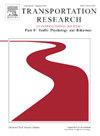货运司机碰撞倾向的预测分析:对潜在风险维度的洞察
IF 3.5
2区 工程技术
Q1 PSYCHOLOGY, APPLIED
Transportation Research Part F-Traffic Psychology and Behaviour
Pub Date : 2025-05-26
DOI:10.1016/j.trf.2025.05.014
引用次数: 0
摘要
本研究调查了货运车辆司机碰撞事件的复杂决定因素,这是伊朗等发展中国家被忽视的问题,在这些国家,高碰撞率突出了进一步研究的迫切需要。主要目的是建立一个基于不同驾驶员群体调查数据的驾驶员碰撞倾向的预测模型。本研究的因变量是报告事故的频率,并从问卷中计算出一组变量作为独立预测因子。对这些因素的深入分析发现了一种新的结构,将这些预测因素分为三个潜在维度:人口统计属性、人格特征和感知风险水平。对导致碰撞倾向的因素进行的有意义的分析强调了人口因素:驾驶员中年,最近的交通违规,高年驾驶里程和有限的驾驶经验是过度增加碰撞风险的重要预测因素。此外,某些人格特征,特别是精神病,以及对感知风险的消极态度增加了崩溃的倾向。这些发现指出,迫切需要针对表现出某些脆弱性的不同驱动因素进行有针对性的、基于证据的干预、教育和政策改革。在这方面,有必要采取一种全面包括社会规范、个人信仰、情感健康和个性因素的方法,以努力提高道路安全和减少涉及货运车辆的撞车事故。通过这样做,政策制定者和感兴趣的利益攸关方将更好地制定有效的战略,以应对货运车辆碰撞事故日益增加的趋势。本文章由计算机程序翻译,如有差异,请以英文原文为准。
A predictive analysis of crash proneness among freight drivers: insight into latent risk dimensions
This research investigates the complex determinants of crash occurrences among freight vehicle drivers, a neglected issue in developing countries like Iran, where high crash rates highlight the urgent need for further study. The primary aim is to establish a predictive model for drivers’ proneness to crashes based on survey data from a diverse driver cohort. The dependent variable of this study is the frequency of the reported accident, and a set of computed variables from questionnaires as independent predictors. In-depth analysis of factors identified a new structure classifying these predictors into three latent dimensions: demographic attributes, personality traits, and levels of perceived risk. The meaningful analyses of factors contributing to crash proneness emphasized demographic elements: driver mid-aged, recent traffic violations, high annual driving mileage, and limited driving experiences are significant predictors of crashing that excessively heighten crash risk. Additionally, certain personality traits, in particular psychoticism, and a negative attitude toward perceiving risks increase proneness to crashing. These findings point out the pressing need for targeted, evidence-based interventions, education, and policy reforms regarding the different driver profiles that manifest certain vulnerabilities. In this regard, there is a need to take an approach that comprehensively embraces the aspects of social norms, individual beliefs, emotional well-being, and personality factors in an effort toward enhanced road safety and reduction in crashes involving freight vehicles. By so doing, policy framers and interested stakeholders will be better placed to develop effective strategies to counter the increasing trend in freight vehicle crashes.
求助全文
通过发布文献求助,成功后即可免费获取论文全文。
去求助
来源期刊
CiteScore
7.60
自引率
14.60%
发文量
239
审稿时长
71 days
期刊介绍:
Transportation Research Part F: Traffic Psychology and Behaviour focuses on the behavioural and psychological aspects of traffic and transport. The aim of the journal is to enhance theory development, improve the quality of empirical studies and to stimulate the application of research findings in practice. TRF provides a focus and a means of communication for the considerable amount of research activities that are now being carried out in this field. The journal provides a forum for transportation researchers, psychologists, ergonomists, engineers and policy-makers with an interest in traffic and transport psychology.

 求助内容:
求助内容: 应助结果提醒方式:
应助结果提醒方式:


